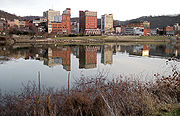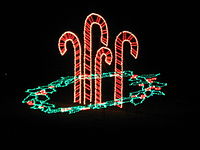- Oglebay Park
-
Oglebay Park
The Oglebay Institute Mansion Museum.Type Municipal park Location Wheeling, West Virginia Coordinates 40°05′59″N 80°39′40″W / 40.09972°N 80.66111°WCoordinates: 40°05′59″N 80°39′40″W / 40.09972°N 80.66111°W Area 1,650 acres (670 ha) Created 1928 Operated by Wheeling Park Commission Visitors information unavailable Status Open all year Oglebay Mansion MuseumBuilt: 1846 Architect: Hanson Chapline, renovations by Edward B. Franzheim and the Klieves, Kraft and Company NRHP Reference#: 79002595[1] Added to NRHP: August 29, 1979 Oglebay Park is a self supporting public municipal park, the only one of its kind, located on the outskirts of Wheeling, West Virginia on 1,650 acres (670 ha). The park has been open to the public since 1928 when the park's governing body, the Wheeling Park Commission, began operations at the former estate of Earl W. Oglebay. In 1926, Earl W. Oglebay donated his summer estate, Waddington Farms, to the city of Wheeling.
Several Waddington Farms buildings, including the Mansion Museum and the greenhouse, remain in use today. Placed on the National Register of Historic Places in 1979, the Oglebay Mansion is operated as a museum by the Oglebay Institute.
The park currently incorporates three championship golf courses, eleven tennis courts, a large outdoor pool, extensive walking trails, the Good Zoo, The Mansion Museum (operated by the Oglebay Institute), gardens, a greenhouse, the Anne Kuchinka Amphitheater, the Wilson Lodge (containing over 200 rooms), 49 cottages, The Schrader Center (a nature center operated by the Oglebay Institute), a planetarium (located within the Good Zoo), a ski slope, Camp Russel, and Schenk Lake, which is used for fishing, pedal boating, Segway tours, and several nightly fountain shows in season.
Annual events at the park include, but are not limited to: The Winter Festival of Lights, Oglebayfest, the Ohio County Fair, the West Virginia Open (tennis), Springfest, and Fort Henry Days (a living history weekend).
Contents
The Oglebay Mansion and Waddington Farm
The Oglebay Mansion was built in 1846 by Paul Matvey as an eight-room farmhouse. Earl W. Oglebay, co-founder of the Oglebay-Norton Company, purchased the mansion and its 25 acres (10 ha) adjoining in 1900, renamed it Waddington Farm, and used it as his summer estate and model farm. He was the ninth owner of the home and its adjoining land, and expanded the farmhouse into a mansion by adding additional wings and architectural features like the front portico. He gradually expanded the estate by purchasing adjacent farms until Waddington Farm had grown from 25 acres (10 ha) to 750 acres (300 ha) at the time of his death in 1926. The mansion became a museum in 1930. The museum, which includes restored rooms, local history exhibits, and exhibits on Earl W. Oglebay and his former estate, is operated by the Oglebay Institute and is open to the public for tours and programs throughout the year
Earl W. Oglebay's hope was to develop Waddington Farm as a model farm, a laboratory for new agricultural changes that could be used to end the great starvation in the United States. He lent out parts of the farm to various researchers so that they could learn about crop rotation, soil improvement, and cost-cutting methods. Waddington Farm once incorporated a dairy farm, a poultry farm, a pig farm, and a sheep farm as well as stables, vineyards, a greenhouse, a rose garden, groves of fruit trees, vegetable gardens for the consumption of those living within the estate, and the areas used to research agricultural techniques. Earl Oglebay's unconventional farming methods resulted in criticism by the agricultural community. To them, he was "a man from the city trying outlandish things", but after they saw the results of his experiments, they thought differently.
The Winter Festival of Lights
This 1985 holiday tradition began at Oglebay Park, but soon spread throughout the city of Wheeling. The first year, displays and landscape lighting covered 125 acres (51 ha) over a three-mile (5 km) drive throughout the resort. The show now covers more than 300 acres (120 ha) over a six-mile (10 km) drive throughout the park. Landscape lighting expert Dick Bosch and the late Robert J. Otten, Wheeling Park Commission’s long-time creative director, were the creative talents behind Oglebay’s show. Bosch’s lighting expertise was needed to produce the lighting for trees and buildings, and Bob Otten designed the first five displays for the 1985 opening and created nearly 50 additional displays until his death in 2005.
Every year, several new displays are added. Notable displays from past years include the Snowflake Tunnel, a display that allows visitors to drive through a lighted tunnel portraying thousands of twinkling snowflakes , the massive Polyhedron Star, which includes over 2,000 lights, and the Poinsettia Wreath and Candle, which is the festival's tallest. Other displays include the Candy Cane Wreath, The Twelve Days of Christmas, and Willard the Snowman, named for the television personality Willard Scott, who switched on the lights for Light-Up Night in 1986. Every year, local students submit new display ideas, and several displays were created at Wheeling Park High School.
Two of the Park's light displays are synchronized to music. "Gardens of Light" and the Good Zoo's "Lighting and Music Extravaganza" were designed by Carson Williams, who created the original Wizards in Winter light display at his home in Mason, Ohio. The Good Zoo's light show, added in 2006, utilizes upwards of 35,500 LED light bulbs and is controlled by a computer. This technology allows the lights to be synchronized with music. The "Gardens of Light" display, which was added in 2007, is very similar to the Good Zoo's light show, but on a much larger scale. In this display, park visitors walk through the gardens, which incorporate hanging flower baskets with lights and lighted flowers in the flowerbeds. The "Gardens of Light" display is an attempt to recreate the look of Oglebay Park's flower gardens during the spring and summer months.
In 2008, Oglebay announced that all new displays will use LED lights, rather than the incandescent lights that were used before. In addition, the Park will gradually convert the existing displays to use LED lights. The new lights will use 85% less energy and last five times longer, according to Oglebay's website.
The Good Zoo
The Good Zoo is a 30-acre (12 ha) facility that houses over 80 species of animals. The zoo was dedicated in memory of a seven-year old boy, Phillip Mayer Good, who loved nature. He was the son of Barbara and Larry Good of Wheeling. The Good Zoo's collection includes African Wild Dogs, North American River Otters, Spectacled Bears, Western Grey Kangaroos, Red-necked Wallabys, Cottontop Tamarins, Ring-tailed Lemurs, an Ocelot, Ostriches, Llamas, goats, two Red-tailed Hawks, Barn Owls, Bald Eagles, Red Pandas, Gorals, a Red-crowned Crane, a Sandhill Crane, a small gang of Meerkats and many other animals from all over the globe. It includes a train, which travels through the ostrich exhibit and all throughout the zoo, and a discovery lab, with an indoor South American Rainforest exhibit. The zoo also features an aviary, which houses red-flanked lorikeets, Goldie's lorikeets, and two subspecies of the Rainbow Lorikeet, the blue mountain (Swainson's) lorikeet, and the green-naped lorikeet. The Good Zoo is the only AZA accredited zoo in the state of West Virginia.
The Good Zoo is also home to a veterinary hospital where visitors can view operations and routine checkups. The hospital is used as a treatment area for zoo animals, a breeding center for certain species, a quarantine area for incoming animals, and a rehabilitation center for injured wild raptors. The zoo's raptor rehabilitation program has successfully treated many raptors and other native birds since its establishment. The zoo's red-tailed hawk, and bald eagles, however, were not able to be returned to their habitat due to severe injuries. They are now ambassadors for the plight of wild raptors and are used in numerous educational programs.
The Good Zoo has many SSP programs. The Species Survival Plan (SSP) is a cooperative breeding and conservation program instituted by the Association of Zoos and Aquariums (AZA). The goal of SSP programs is to help as many species as possible through captive breeding, education, research, and habitat preservation.
Annual events at the Good Zoo include "Boo at the Zoo" (in October), "The Good Zoo Lights Up For You" (during the Festival of Lights), an annual car show at nearby Camp Russel, and an Easter egg hunt (in April).
References
- ^ "National Register Information System". National Register of Historic Places. National Park Service. 2008-10-20. http://nrhp.focus.nps.gov/natreg/docs/All_Data.html.
External links
- Oglebay Resort & Conference Center
- Oglebay's Calendar of Events
- The Museums of Oglebay Institute
- National Register of Historic Places, Ohio County, West Virginia
- The Good Zoo Web site
City of Wheeling Topics Attractions • Economy • Education • Entertainment • Geography • Government • History • Infrastructure • Media • People
Top subjects Alma Grace McDonough Health and Recreation Center • Bloch Brothers Tobacco Company • Hazel-Atlas Glass Company • The Intelligencer & Wheeling News Register • Marsh Wheeling • Oglebay Park • Ohio Valley and Eastern Ohio Regional Transportation Authority • Reymann Brewing Company • WesBanco Arena • West Virginia Independence Hall • Wheeling Island • Wheeling Island Stadium • Wheeling Jesuit University • Wheeling ParkSuburbs The Northern Panhandle of West Virginia Counties 
Communities Beech Bottom | Benwood | Bethlehem | Bethany | Cameron | Chester | Clearview | Follansbee | Glen Dale | McMechen | Moundsville | New Cumberland | New Vrindaban | Triadelphia | Valley Grove | Weirton | Wellsburg | West Liberty | Wheeling | Windsor Heights
Attractions Bethany College | Capitol Theatre | Chester Teapot | Grave Creek Mound | Mountaineer Casino, Racetrack and Resort | Oglebay Park | Palace of Gold | Tomlinson Run State Park | West Liberty University | West Virginia Independence Hall | West Virginia Northern Community College | West Virginia State Penitentiary | Wheeling Island | Wheeling Island Hotel-Casino-Racetrack | Wheeling Jesuit University | Wheeling Suspension Bridge | The Highlands Shopping, Dining & Entertainment Complex
Zoos of West Virginia - Oglebay's Good Zoo
- West Virginia State Wildlife Center
U.S. National Register of Historic Places in West Virginia Lists by county Barbour • Berkeley • Boone • Braxton • Brooke • Cabell • Calhoun • Clay • Doddridge • Fayette • Gilmer • Grant • Greenbrier • Hampshire • Hancock • Hardy • Harrison • Jackson • Jefferson • Kanawha • Lewis • Lincoln • Logan • Marion • Marshall • Mason • McDowell • Mercer • Mineral • Mingo • Monongalia • Monroe • Morgan • Nicholas • Ohio • Pendleton • Pleasants • Pocahontas • Preston • Putnam • Raleigh • Randolph • Ritchie • Roane • Summers • Taylor • Tucker • Tyler • Upshur • Wayne • Webster • Wetzel • Wirt • Wood • Wyoming

Other lists Keeper of the Register • History of the National Register of Historic Places • Property types • Historic district • Contributing property Categories:- Landmarks in West Virginia
- Parks in West Virginia
- National Register of Historic Places in West Virginia
- Wheeling, West Virginia
- Zoos in West Virginia
- Houses completed in 1846
- Greek Revival architecture in West Virginia
- Protected areas of Ohio County, West Virginia
- Visitor attractions in Ohio County, West Virginia
- Museums in Ohio County, West Virginia
Wikimedia Foundation. 2010.



